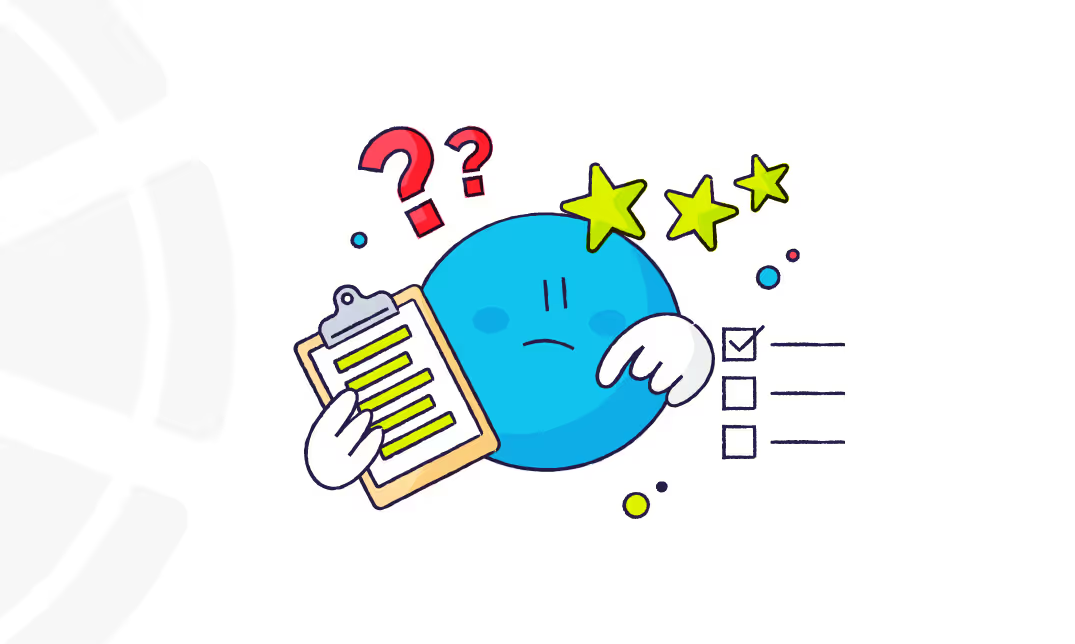Surveys serve an important role in companies’ customer experience (CX) process. They allow companies to learn about their customers and gather valuable data and insights. The type of surveys run and the survey questions asked will depend on the issues or hypotheses a company has about its customers.
For businesses to get the most out of their surveys, it’s important to ask the correct survey questions. The guide below will discuss different survey question types, tips on when to use them, and how to word survey questions for the best customer insights.
To create easy-to-read survey questions, head to our survey question templates below.
Table of Contents:
- What Are Good Survey Questions?
- Types of Survey Questions
- 71 Survey Question Examples
- Demographic Survey Questions
- General Survey Questions
- 6 Tips For Writing Excellent Survey Questions
What Are Good Survey Questions?
Part of running a successful survey means knowing what goals you have in mind beforehand. A strong questionnaire within a survey will reveal to a company valuable insight into their current or prospective customer base.
Good survey questions will reveal to a business who their target market is, what clients think of the business’s customer experience, and what’s influencing people’s purchasing decisions. After conducting surveys and analyzing the results, companies can adjust their CX, marketing, advertising, sales, and PR strategies to better address customers’ needs or concerns.
Types Of Survey Questions
In general, there are two types of survey questions: closed-ended and open-ended. Closed-ended contains a predefined list of answer choices and is best for collecting quantitative data. Open-ended questions allow for the respondent to write their own answer, which leads to more qualitative data.
The following list contains the most common of each type of survey question.
Open-Ended Questions
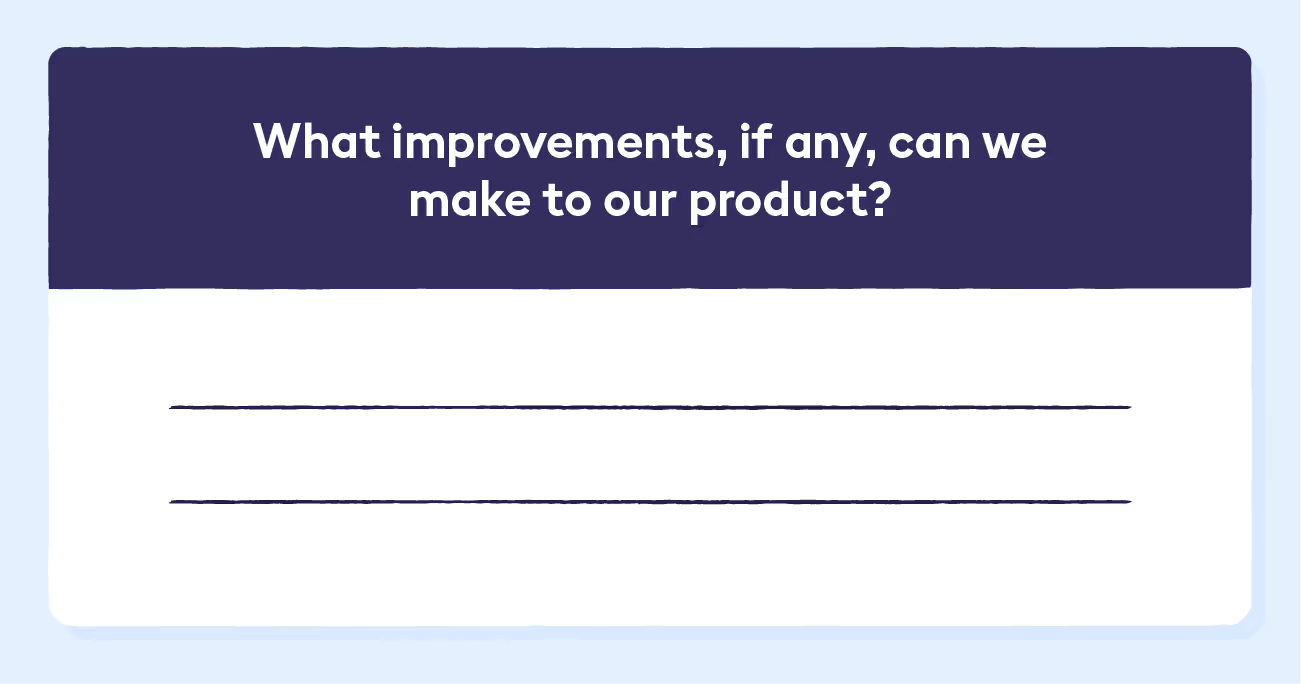
Open-ended survey questions require respondents to write their answers. There are no preset answer options. Open-ended survey questions are best for providing qualitative data, which can be analyzed and turned into quantitative data with sentiment analysis and text analytics tools. Typically, open-ended questions work best when paired with closed-ended questions.
Closed-Ended Questions
Closed-ended questions encompass a broad category of different question types. They limit a respondent’s response options to predetermined choices. Closed-ended questions are best for gathering quantitative data and testing individual hypotheses. The survey questions below are types of closed-ended questions.
Rating Scale Questions
Rating scale questions also referred to as ordinal questions, give a scale of numerical answer options that relate to a specific sentiment or emotion such as satisfaction, content, displeasure, etc. The respondents choose a number that best correlates with their sentiment or feeling. The numbers give context to what degree someone feels a certain emotion.
Rating scale questions are best at gathering quick quantitative data and can be used on a mass scale.

Likert Scale Questions
Likert scale questions measure to what extent a respondent agrees or disagrees with a statement. They’re typically done on a five-, seven-, or nine-point scale. Note that the median number on the scale usually indicates neutrality.
Similar to rating scale questions, Likert scale questions measure sentiment. They can involve numeric values but don’t have to, unlike rating scale questions, which need a number. Additionally, Likert scale questions are more upfront and direct with the proposed hypothesis or question at hand than rating scale questions.
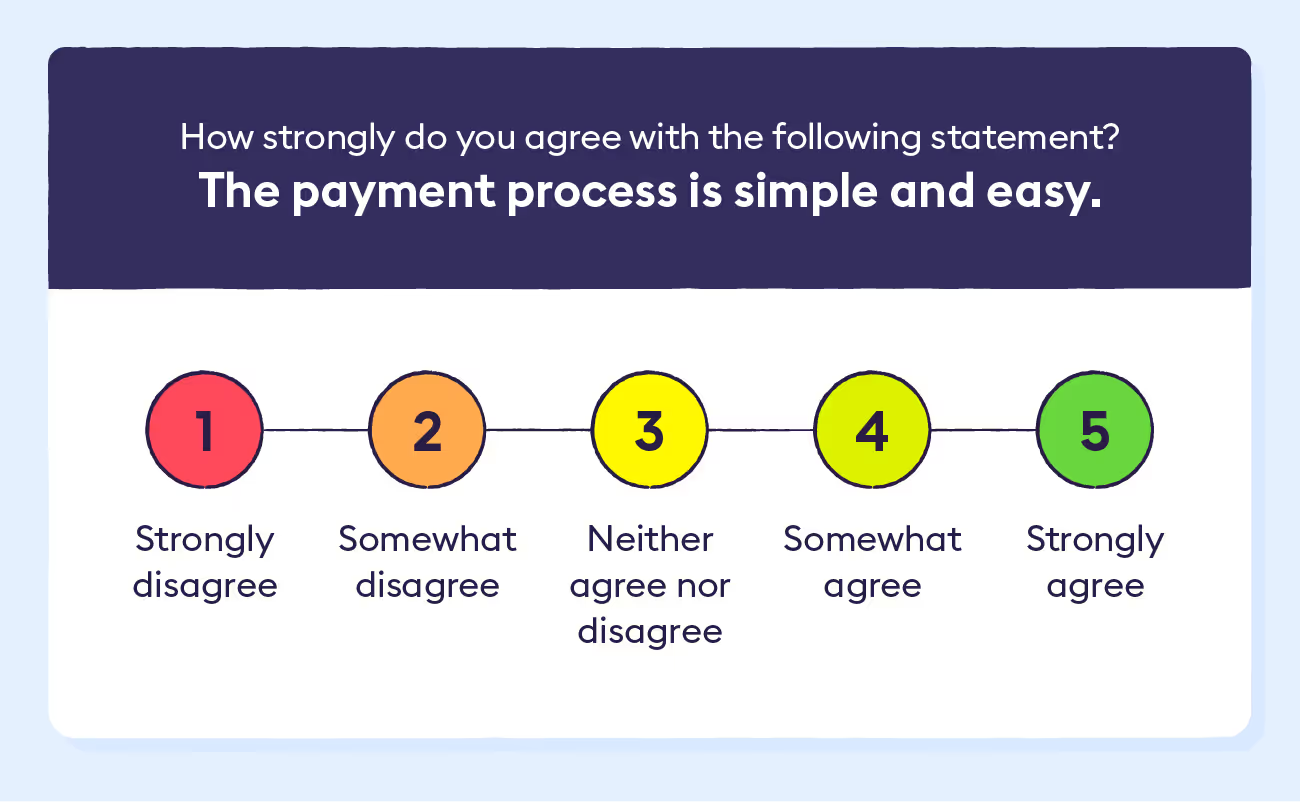
Demographic Questions
Demographic survey questions allow companies to gather information or data on their customers or target audience. They’re more personal questions about a person’s demographics (sex, age, occupation, marital status, degree of education, etc.).
Demographic questions help businesses narrow down their target audience and help guide marketing, PR, advertisement, and sales decisions.
Multiple-Choice Questions
Simply put, multiple-choice questions allow surveyees to select one or more options from a list of predefined answer choices. They’re easy and quick for respondents to answer, which allows businesses to ask more questions without tiring respondents out and receiving high response rate drop-offs.

71 Survey Question Examples
The section below contains a list of insightful survey questions to ask customers. Used strategically, a variety of question types will help accomplish the survey’s objectives. The categories and list below will hopefully inspire some strong survey questions to ask clients.
Net Promoter Score (NPS) Questions
Net Promoter Score (NPS) measures the likelihood of a customer recommending a brand or company to someone else. Frederick F. Reichheld founded the term NPS and strategy in his seminal article.
Reichheld found that a customer’s willingness to promote or advocate for a company correlated to customer loyalty and growth potential. Since then, it’s been a key performance indicator (KPI) for many businesses to better understand their customer loyalty.
The NPS survey question is fairly simple and is often asked in one specific way as a rating scale question.
- How likely are you to recommend us to a friend or colleague?
For more qualitative data, an NPS survey will typically follow up with an open-ended question such as:
- What made you select that particular choice?
- Can you explain your reasoning for giving that score?
For more information on NPS surveys, see our guide on how to measure an NPS score and try our NPS calculator. You can also use our NPS survey template below.
Customer Effort Score (CES) Questions
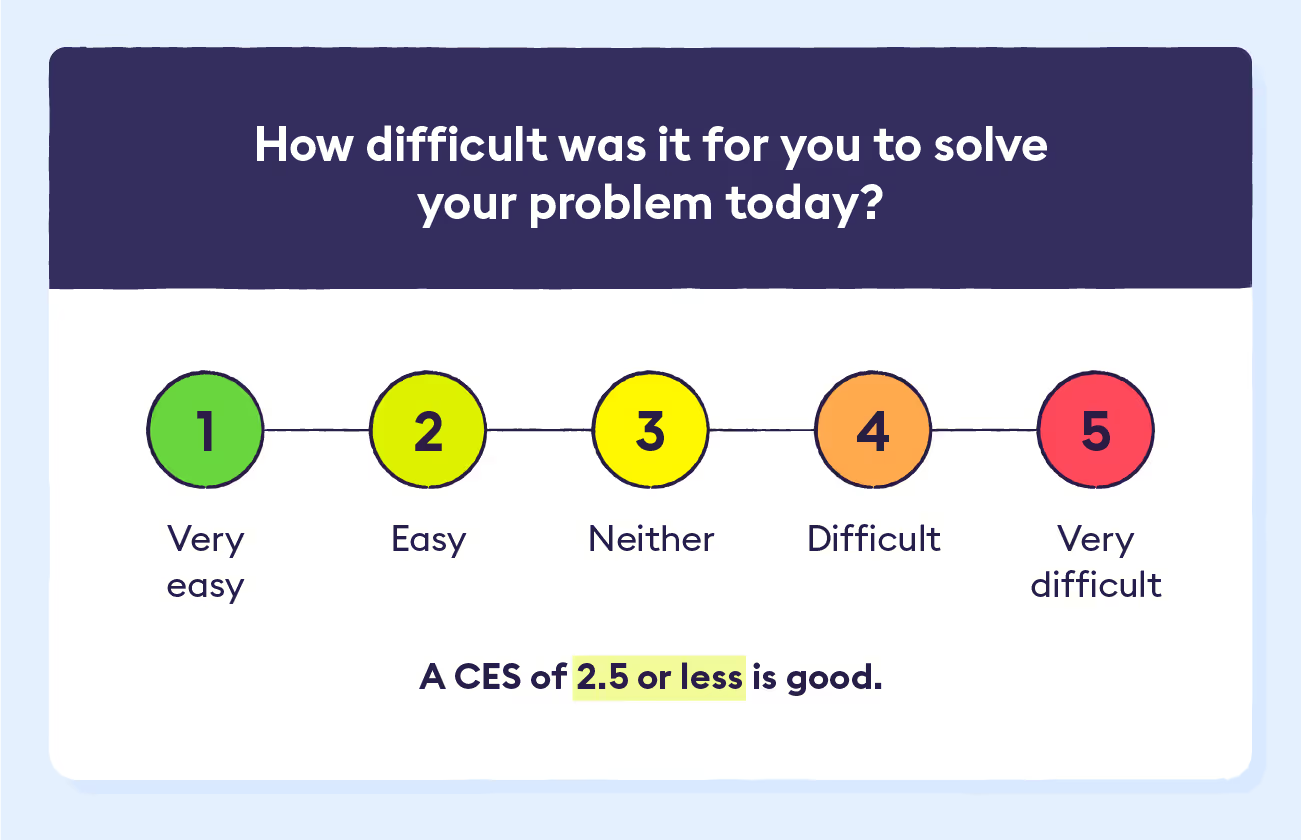
Customer effort score (CES) helps to quantify the difficulty a customer experienced when trying to resolve a problem or issue. The higher the amount of effort (higher CES) the more likely a customer will churn or bad-mouth a company to others online or in person. Vice versa, a low CES often translates to positive word-of-mouth traffic and an increased NPS.
Businesses should send CES surveys immediately following an interaction with a customer, such as after a product demo or trial, after an interaction with a customer service representative, or after a purchase.
Below are examples of CES survey questions in both rating scale and Likert scale form:
- How easy was it to purchase from us today? (rating scale)
• Difficult • Neutral • Easy
- How intuitive is our website? (Likert scale)
• Not intuitive • Not very intuitive • Neutral • Somewhat intuitive • Very intuitive
- How was your experience with our customer service department? (rating scale)
• Very difficult • Difficult • Neutral • Easy • Very easy
For easy-to-use CES surveys, download our CES survey template below.
Customer Satisfaction (CSAT) Questions
Customer satisfaction (CSAT) surveys help businesses measure how satisfied customers are with a product or service. Businesses can measure CSAT by using rating scale questions in their surveys. Similar to CES surveys, the CSAT ranking scale is usually on a scale of 1–5 or 1–10. The higher numbers typically correspond to a more satisfied customer.
Here are a few examples of CSAT rating scale survey questions:
- How satisfied are you with our product? (Likert scale)
• Dissatisfied • Somewhat dissatisfied • Neutral • Somewhat satisfied • Very satisfied
- How would you rate your experience with our customer service representative, (first name)? (rating scale)
• Not Great • Could Improve • Okay • Good • Great
To create CSAT surveys, try out our easy-to-use CSAT survey template.
Demographic Survey Questions
Demographic survey questions provide businesses key data and information on either their current or prospective clients.
Demographic survey questions can be broken down into two categories: business/industry questions or personal questions. Regardless of the category, use our demographic survey questions guide to write inclusive demographic survey questions.
Business Or Industry Demographic Question Examples
Business-type questions gather demographic information on a person's professional life, such as their specific role or industry. This way, B2B companies can better understand and target their customer base.
Example business demographic questions below:
- What industry best describes your company?
• Retail • Travel • eCommerce • SaaS • Lead Generation • Other
- What best describes your role/position?
• Director • Manager • Associate • Specialist/Team Member • C-Level Executive
- Which department do you work in?
• HR • Marketing/Advertising • Sales • PR • IT • Engineering/Dev • Other
- What is your current employment status?
- What company do you work for?
- What is your company’s annual revenue?
- How many employees does your company have?
Personal Demographic Question Examples
Personal demographic survey questions center around a customer or target audience’s individual lives and characteristics. They’re useful for segmenting businesses’ audiences so that the company can take a deeper dive into their data and varying populations.
Example personal demographic questions below:
- What is your sex?
- How old are you?
- Which ethnicity do you identify as?
- Where is your home located?
- What is the highest degree or level of education that you have completed?
- Are you married?
- What is your combined annual household income?
- How many children do you have?
- Which languages do you speak fluently?
- Are you Hispanic?
- If applicable, what religious affiliation do you belong to?
- How would you describe your political views?
General Survey Questions
The survey questions below are general questions that eCommerce, SaaS, B2B, and B2C companies can ask customers throughout the customer journey. The questions should be asked depending on which stage of the customer journey the client is currently in.
Awareness Survey Questions
For businesses seeking out how an individual came across their brand and what their initial impression is, consider incorporating the awareness questions below into your next survey.
- How did you come across our company?
- What was your first impression of our website?
- Are you on mobile or desktop?
- Which of the following brands have you heard of?
- When did you first discover our brand?
- How familiar are you with our company?
- What industry do you think we serve?
Consideration And Pre-Purchase Survey Questions
Potential customers in the consideration stage or pre-purchase phase are more acquainted with a brand or business than those in the awareness phase. They’ve done a good amount of research but are still hesitant to buy.
The below examples will give companies insight into how potential customers perceive their business compared to competitors.
- What issues is your business experiencing?
- Are you considering any of the following competitors?
- Did you look at online reviews?
- What persuaded you to begin the trial?
- What information stuck out to you?
- What is your biggest concern or fear with our product?
- What other information would you like to see on this page?
- What is influencing you the most to purchase from us?
Decision And Post-Purchase Survey Questions
The decision stage is when it’s time for a prospective buyer to turn into a customer by purchasing a product or service. The alternative is that they decide to go with a competitor or pass on similar products or services entirely.
Decision or post-purchase survey question examples include:
- Did you make a purchase today? If not, what stopped you?
- Were you satisfied with our product demo?
- What is your biggest fear or concern about purchasing from us?
- What’s the one thing that almost stopped you from purchasing today?
- Which other options did you consider before choosing [product name]?
- Did you look at online reviews before making your decision?
- Did you compare our product to any of the competitors below?
Retention Survey Questions
According to Bain & Company, a 5% increase in customer retention can increase a company’s profit by 25%. Part of retaining customers means listening to their voices.
Retention survey questions need to inquire about what the clients like, dislike, want more or less of, and ways the company can improve. Answers to these questions will help businesses better understand and retain their customers.
Retention survey question examples include:
- How do you like the product so far?
- On a scale of 1–10, how would you rank our product?
- How much effort did it take to resolve your issue(s) today?
- How satisfied were you with customer support?
- How long did it take to resolve your issue?
- Would you purchase from us again? Why or why not?
- What could we do to offer you a better experience?
- What is the next product you think we should build?
- Will you purchase more products from us in the future?
- What are you most satisfied with?
- What are you least satisfied with?
- On a scale of 1–5, how is the quality of our product?
Advocacy Survey Questions
An important metric for companies that want to know their customer lifetime value is determining to what extent their customers enjoy their products or services. Are customers willing to advocate on the company’s behalf? Or are there pain points or bottlenecks impeding recommendations from happening?
Here are a few advocacy survey question examples companies should ask to understand how much customers value their business:
- How likely are you to recommend us to a friend or colleague? (NPS question)
- Are you interested in becoming a social media influencer for us?
- What do you like best about our platform?
- What annoys you most about our platform?
- Are you interested in a rewards program?
- What type of rewards do you care about most?
- On a scale of 1–10, how interested are you in becoming an advocate for us?
- How would you feel if you could no longer use our product?
- Compared to our competitors, how would you rate our services?
- If you were to write an online review of product X, what would you say?
6 Tips For Writing Engaging Survey Questions
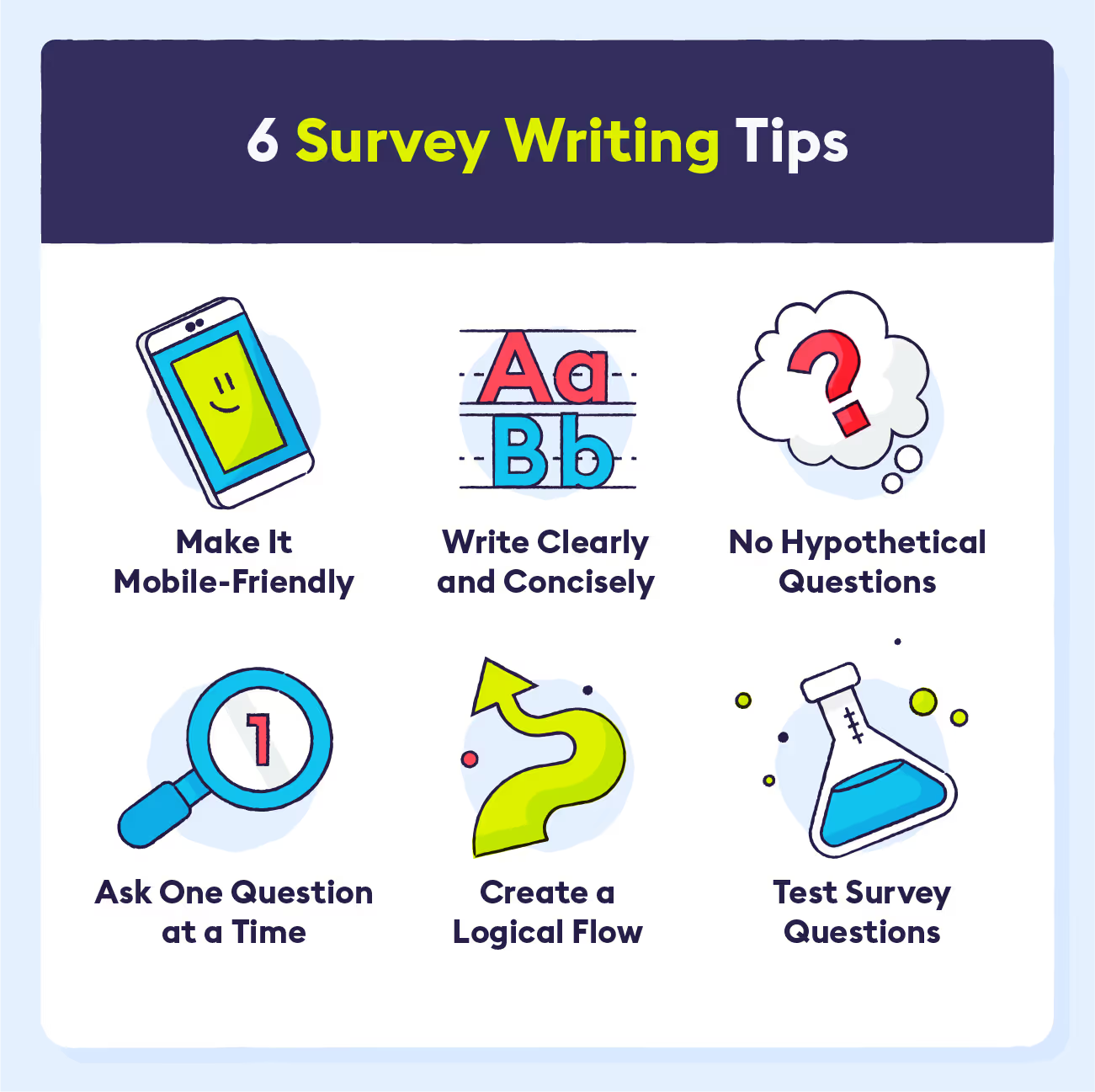
Regardless of the survey question type, for surveys to be successful, the questions must be easy to understand and answer. The tips below will explain how to write intriguing and straightforward survey questions, which will increase the completion rate and accuracy.
1. Mobile-friendly
Since 60% of people open emails on their mobile phones, surveys sent via email should be easy to read and quick to take on mobile devices.
2. Create clear and concise questions
Survey questions must be easily digestible and as concise as possible. Hard to interpret or heavily worded questions will result in a lower response rate and frustrated respondents, both of which can affect the survey’s accuracy.
3. Don’t ask hypothetical or what-if questions
Hypothetical or what-if questions don’t reflect real life and are therefore not particularly accurate questions. People often feel different when faced with a real choice instead of a hypothetical situation.
4. Ask one question at a time
Don’t confuse respondents by overwhelming them with multiple questions. Ask one question at a time, and divide complicated inquiries into multiple questions for more reliable answers.
5. Ask questions in a logical manner
Some survey questions are meant to build on one another. For example, follow-up questions based on respondents’ answers are likely open-ended questions that give more qualitative feedback and information.
6. Test questionnaire or survey questions
Make sure to always test a questionnaire or survey questions by asking internal teams for feedback or by running a low-cost mock survey to see if people have issues with how questions are worded.
When creating customer surveys, remember to have key objectives in mind. A survey's questions will depend on what issues a company faces and aspires to uncover. Once the questions are created, make sure to review them for clarity and grammatical errors, and test them internally. Use our guide on tips for avoiding bad survey questions to thoroughly check your survey questions before sending them out.
To create easy-to-answer survey questions, download our survey question templates here:
Sources: Harvard Business Review | Bain & Company | 99 Firms


